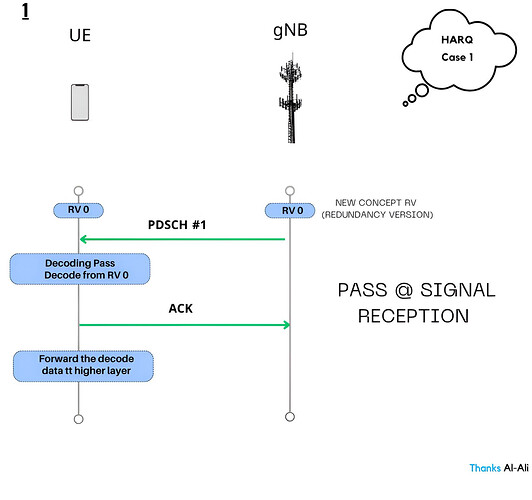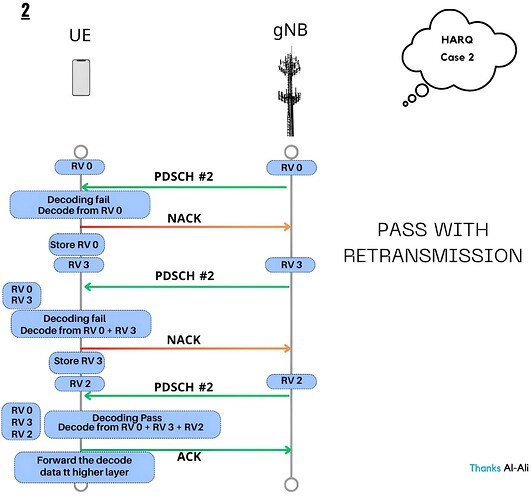Hybrid ARQ (HARQ) is a key technology in wireless communications, like 4G and 5G, designed to make data transmission more reliable. It combines two strategies:
- Forward Error Correction (FEC): Extra bits are added to the data so that small errors can be corrected without needing retransmissions.
- ARQ (Automatic Repeat Request): If the receiver detects errors it can’t fix, it asks for the data to be resent.
How Does HARQ Work?
Case 1: Successful Transmission on First Attempt:
- gNB transmits PDSCH (Data) with rv 0 to the UE over the PDSCH.
- Your phone checks for errors. If everything is okay, it sends an “ACK” (acknowledgment) back to the base station, saying, “All good!”,The UE receives the data and performs error detection using the CRC (Cyclic Redundancy Check).
- ACK/NACK: If the CRC is OK, the UE sends an ACK message to the eNodeB through PUCCH or PUSCH, indicating successful reception.
- Since the transmission was successful, there is no need for retransmissions in this case. There is no need to save the data in HARQ buffer and UE forward the decoded data to higher layer.
Case 2: Pass with Retransmissions:
- First Transmission: gNB sends PDSCH with RV 0. UE fails decoding (CRC fails) and sends a NACK.
- First Retransmission: gNB sends the same data with RV 3. UE combines it with the previous transmission but still fails decoding, sending another NACK.
- Second Retransmission: gNB retransmits with RV 2. UE combines all received transmissions, successfully decodes the data (CRC passes), and sends an ACK.
What is Redudandancy Version (RV)
When data is sent, it’s encoded with extra information to help correct any errors. The Redundancy Version (RV) decides which parts of the encoded data are sent in each transmission. Different RVs (like RV 0, RV 3) send different chunks of the data, making it easier for the receiver to piece everything together correctly. This way, if the first attempt fails, the receiver gets new parts in the next try, increasing the chances of successful decoding.
Hybrid ARQ with Soft Combining (HARQ)
In NR (5G), HARQ is used to improve data transmission when errors occur. When a packet is received with errors, the system requests a retransmission. Instead of throwing away the first packet, it is saved and combined with the new one. This increases the chances of decoding the data correctly.
There are two ways to do this:
- Chase Combining: Retransmits the same data as the original. It’s simple and uses less memory, but it doesn’t work as well when there’s a lot of data to correct.
- Incremental Redundancy: Sends different pieces of the data each time (different bits). This method performs better, especially when the error rate is high, but requires more memory and is more complex.
Note : HARQ is for Data traffic only, ARQ in 3G, HARQ in LTE,5G ![]()
LinkedIn: ![]()

